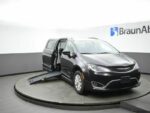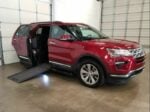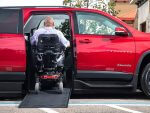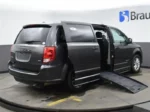Side-Entry Wheelchair Vans
The Mobility Resource offers a wide selection of side-entry wheelchair vans. During your search for the right mobility van for your needs, please note that no vehicle allows for both rear and side-entry at the same time. However, all of our available brands do allow for side-entry wheelchair ramps or lifts, so you can pick your preferred make from notable OEMs, including Chrysler, Chevy, Dodge, Ford, Honda, and Toyota. Side-entry wheelchair vans offer more flexibility for the user, and in most cases, increased freedom and self-reliance. There are also more powered ramp options, including power and manual in-floor wheelchair ramps, with side-entry access, making it a better overall user experience for people with disabilities. Browse The Mobility Resource’s inventory to find both new and used side-entry wheelchair vans for sale from popular brands such as Chrysler, Toyota, Honda and Ford. Individuals seeking special financing on these vehicles can refer to The Mobility Resource’s flexible financing options for further information.
Handicapped vehicles can be found in both rear and side-entry — the right selection will depend on your particular circumstances. Keep reading to learn the benefits of a Side-Entry conversion.
Let’s look at the benefits of a side-entry wheelchair van conversion.
Side-Entry Wheelchair Van Benefits
- Competitive Resale Value - Side-entry wheelchair vans are more requested and therefore have a higher resale value.
- Options From Popular Brands - Chrysler, Toyota, Dodge, Honda and Toyota offer side-entry handicap vehicles.
- More Floorplan Flexibility - Side-entry conversions offer more flexibility in terms of floor plan configurations. They allow access to the center of the vehicle or the two front seating positions. Wheelchair users can use the wheelchair in either front seat location or transfer to the OEM seat with an available transfer seat base. A side entry wheelchair van keeps the rear bench seat in place, with seating for up to 5 people, plus the wheelchair user.
- Increased Freedom for Wheelchair Users - Side-entry conversions give users the ability to drive the vehicle from their chair or sit next to the driver.
- Comfortable Exit & Entry - Side-entry conversions offer room to maneuver the wheelchair around inside the vehicle, allowing the wheelchair user to enter and exit the vehicle facing forward. (In a rear-entry wheelchair conversion, the user must exit backing up.)
- More Ramp Options - Side-entry vans also provide multiple ramp options, including manual and power, fold-out ramps and in-floor ramps that stow under the van once the door is closed.
- More Vertical Space - Side-entry vehicles feature a lowered-floor design that offers more accessibility to the driver’s seat, as well as more room when entering, exiting and traveling in the vehicle.
So, what are the drawbacks of a side-entry conversion?
Side-entry Drawbacks
- More Expensive – Due to the nature of the modification, side entry conversions are more expensive than rear entery conversions. The price of a side-entry conversion typically runs between $25,000 and $40,000.
- Fewer Parking Options - Side-entry wheelchair vans require room next to the van to deploy their ramps, which can be difficult in busy parking lots. As such, these vans can only park somewhere that has appropriate space on the side. As a result, driving a side-entry van can make parking more complex. However, when entering and exiting the vehicle, you are not in the traffic lane.
- Requires a Wider Driveway or Garage - Side-entry vehicles need added space on the side for ramp deployment which requires ample garage or driveway space for loading and unloading.
Available Side-Entry Vehicles
Select Side-Entry wheelchair accessible vans converted are available within The Mobility Resource's inventory:
Types of Side-Entry Conversions
Side-entry wheelchair accessible vehicles can be found with manual fold-out and power fold-out ramp options. The right selection will depend on your particular circumstances, preferences and budget. Keep reading to learn the difference between power and manual wheelchair van conversion ramps.
Power Fold-Out Wheelchair Ramps
- Fold-out ramps must be stowed in an upright position blocking the doorway. This can make it more difficult for ambulatory (able-bodied) passengers to enter and exit the vehicle conveniently.
- Power fold-out ramps are more expensive due to the automatic system that allows the ramp to open and close with the click of a button.
- Power wheelchair ramps are more convenient and user friendly than manual wheelchair ramp conversions.
- Power foldout ramps require occasional preventive maintenance every six months to ensure trouble-free operation.
- Power fold-out ramps on a side-entry minivan are the most popular wheelchair vans being sold today.
Manual Fold-Out Wheelchair Ramps
- Fold-out ramps must be stowed in an upright position blocking the doorway. This can make it more difficult for ambulatory (able-bodied) passengers to enter and exit the vehicle conveniently.
- Manual wheelchair ramps are a more affordable option for budget-conscious buyers.
- The caregiver is required to lift and stow the ramp using a handle built into the frame of the ramp. Although it is less convenient, these well-designed ramps are still user-friendly and highly functional.
- Manual foldout ramps are very simple to operate and the least likely style to need maintenance due to its simplistic design and lack of having any motorized components that could fail.
Power In-Floor Wheelchair Ramps
- In-floor wheelchair ramp conversions are also called ‘slide out’ ramps.
- Power in-floor ramps are typically the most expensive wheelchair ramp conversions (depending on the year, make, trim level and mileage) due to the automatic system that allows the ramp to open and close with the click of a button.
- In-floor van ramps are stored in the floor and out of the way, providing more space in the vehicle and more room for other passengers to easily enter and exit the vehicle.
- Power wheelchair ramps are more convenient and user friendly than manual wheelchair ramp conversions.
- Power in-floor ramps require occasional preventive maintenance every six months to ensure trouble-free operation.
Manual In-Floor Wheelchair Ramps
- In-floor wheelchair ramp conversions are also called ‘slide out’ ramps.
- In-floor minivan ramps are stored in the floor and out of the way, providing more space in the vehicle and more room for other passengers to easily enter and exit the vehicle.
- The caregiver is required to pull the ramp out using a device that attaches to the end of the ramp, as well as storing it after use. Although it is less convenient, these well-designed ramps are still user-friendly and highly functional.
- Manual in-floor wheelchair ramps are a more affordable option for budget-conscious buyers.






